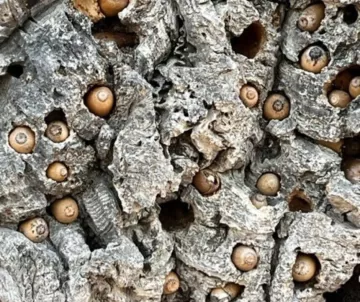
May 7, 2024
Saratoga Planning Commission
Dear Chair Brownley and Saratoga Planning Commissioners,
The Santa Clara Valley Audubon Society and the Sierra Club Loma Prieta Chapter are organizations united by our shared commitment to the protection of the environment, nature, and open space. We submit this letter to highlight our ongoing interest in the long-term survival of the majestic Cork Oak tree (#136) and its Acorn Woodpeckers1 at the Saratoga Retirement Community during implementation of the Master Plan Update.
SCVAS submitted comments on the Draft Environmental Report for this project and both Sierra Club and SVCAS representatives attended public meetings. In these communications, we provided recommendations for minimizing light pollution, and for designing bird-friendly structures to reduce the potential of bird collisions with glass. We acknowledge and appreciate the incorporation of our proposed measures into the project and agree that this reduces the potential impact to birds from bird strikes and/or confusion would be less than significant.
Acorn Woodpeckers are unique, beautiful and entertaining birds. They live in a rambunctious, vocal and active family group and raise their young all together. These birds are of importance to our members, and thus so is the survival of the majestic cork oak (tree number 136). This tree, and the family (‘bushel’2) of acorn woodpeckers that call it home, provide residents of the community (and Saratogans at large) with a unique exposure to the vibrant, vocal and entertaining nature of the woodpecker family life, and contribute to residents’ health, well being and sense of belonging. The loss of this bushel of acorn woodpeckers should be perceived as a traumatic event not only to the woodpeckers themselves, but also to the community that loves and appreciates them.
We acknowledge that the cork oak is in relatively poor health, but see it as imperative that the City of Saratoga makes a sincere effort to protect the tree and help it survive. To achieve this, we encourage the City to proceed with Alternatives 1 or 2, which propose no construction activities in the vicinity of the tree. If Alternative 3 is selected, we encourage the City to redesign the proposed project in a way that minimizes grading and excavation within the critical root zone of the tree at West Cottage Lane and consider using root fertilization methods to stimulate root development on the opposite side.
We thank you for the consideration of our comments,
Shani Kleinhaus
Environmental Advocate
Santa Clara Valley Audubon Society
Dashiell Leeds
Conservation Coordinator
Sierra Club Loma Prieta Chapter

1 Please watch this .5 minute video of Acorn Woodpeckers; see also Acorn Woodpeckers in Five Acts
2 A group of Acorn Woodpeckers is known as a "bushel" — a perfect description for this bird's unusual habit of squirreling away large quantities of acorns in granaries or "acorn trees." Some of these granary trees have up to 50,000 holes — drilled, stocked, and maintained by extended Acorn Woodpecker families.